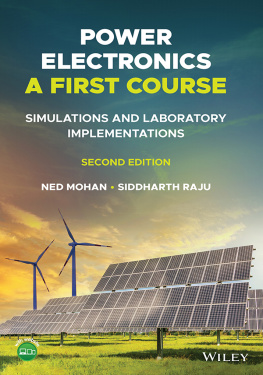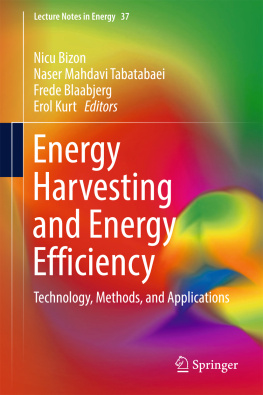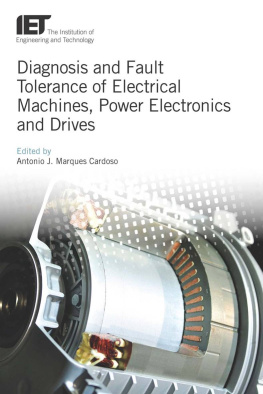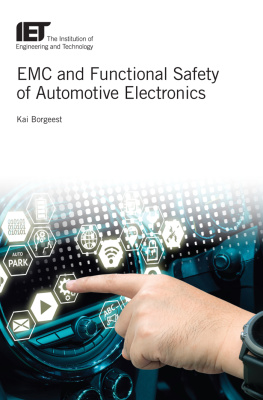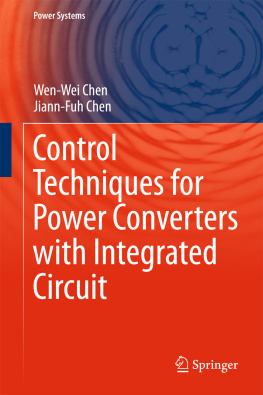Power Electronics
Advanced Topics and Designs
Volume 3
Slobodan uk
Copyright C 2015 Slobodan Cuk
Certain sections, identifies on the title page, were originally published by the IEEE, and are republished by permission. Certain other sections, also identified on the title page, were originally published in Proceedings of POWERCON R, and are reprinted by permission of Power Concepts, Inc. Powercon is a registered trademark of Power Concepts Inc., Ventura, CA.
ISBN-13: 978-1519520296
ISBN-10: 1519520298
Library of Congress Control Number: 2015919978
Foreword to four volume series
This four volume series is an updated version of the three volume series published originally by TESLAco in 1983 as a second hardcover edition with Volume 1 and Volume 2 printed in one hardcover and volume 3 in a second hardcover. The first paperback edition published in 1981 consisted of the first two volumes only. This third edition now has an additional fourth volume. The subtitles of this four volume series are: Topologies, Magnetics and Control (vol. 1); Modeling, Analysis and Measurements (vol. 2); Advanced Topics and Designs (vol. 3); State-Space Averaging and uk converters (vol. 4).
The second edition published by TESLAco has been out of print for a number of years. It is now offered for the first time via Amazon books and their subsidiary CreateSpace, which will insure their continuous availability.
The objective of this series is to serve as a textbook to engineers entering this field as well as a reference to experienced practicing Power Electronics specialists. The technical papers collected herein were written in the 1970s when Power Electronics was just being recognized as a field worthy of the fundamental academic research. Therefore the technical papers selected had a twofold objective: to advance the field with new research results and at the same time to educate the Power Electronics community at large. This material is now crucial for the understanding of my Hybrid and Storageless Switching Methods and a number of related new converter topologies and respective magnetics and control improvements.
I had been using these four volumes and companion course notes as a textbook successfully in teaching my two quarter EE 117 course at Caltech for 25 years. Although listed as a graduate course, it was taken by a number of undergraduate students ranging from sophomores to seniors. Hence a very basic approach was used requiring little prerequisite knowledge other than fundamental linear circuit theory. I am very pleased to have met a number of practicing engineers who confirmed that they got into the Power Electronics field owing to having access to these books, learning from them and proceeding to have a long and satisfying career as Power Electronics specialists. I have also used these books as textbooks for my five- day public and in-house courses, which, by now, have been attended by over 4,000 Power Electronics specialists worldwide.
This year I have for the first time begun presenting tutorials at conferences and industry seminars that are focused on my latest research contributions and inventions. Naturally, these seminars also have a substantial review of classical topologies, magnetics and control so the latest advances in all three areas can be thoroughly understood.
Slobodan uk, Laguna Niguel, CA 92677
November 24, 2015
Foreword to Volume 3
In the two years since the publications of Volume 1 and 2 paperback edition in 1981, The Advances in Switched-Mode Power Conversion, a number of new publications were made by the Power Electronics Group at Caltech and design engineers at TESLAco to warrant their collection in this third volume named here Advanced Topics and Designs. The chapters are formed based on the chronological order of their publications date. While the principal purpose of these publications were to introduce the research results, the same approach as used in previous published papers was used to provide the new material in a pedagogical context so as to orient the reader in the motivation, background, and objectives of the new work. A consequence of this dual purpose is that many papers have been quite long, and have thereby caused to the editors of certain publications, causing some of them to impose a substantial page charge for exceeding what was, to us, at least, a rather modest page limit.
As a result, Caltech Power Electronics Group adopted a new policy of writing the two versions: a short one for writing in conference proceedings and a long one for including in the books like this. Hence contain the long version. As the enclosed 21 chapters cover a broad range of topics, in order to help the reader orient themselves, here is a grouping of the chapters based on the topics covered along with the short description.
Modelling and Analysis ()
The deal with the large-signal analysis of switched-mode converters.
Magnetics ()
).
Cuk converter practical designs ()
Independent regulation of Multiple Outputs ()
DC-to AC inversion ()
Review papers ()
review the coupled-inductor and the more general integrated magnetics method, not only with the objective of reducing the size and weight and increasing efficiency but also at the same time achieving zero ripple currents in both input and output of PWM switching converters.
Slobodan uk, Laguna Niguel, CA 92677
November 24, 2015
Power Electronics: Advanced Topics and Designs
1
SAMPLED-DATA MODELING OF SWITCHING REGULATORS
ARTHUR R. BROWN AND R.D. MIDDLEBROOK
ABSTRACT
The high-frequency capabilities of two switching regulator modeling techniques, state-space averaging and discrete modeling, are compared. A new linear, small-signal modeling technique, which combines the continuous form of state-space averaging with the accuracy of discrete modeling, is then developed. This new method, called sampled-data modeling, succeeds, where state-space averaging fails, in predicting the subharmonic instability in current-programmed regulators, and is shown to be of significant usefulness in the design of high-performance switching regulators.
1.INTRODUCTION
Switching converters and regulators do not fall into the class of linear, time-invariant circuits to which accurate and straightforward analysis tools, such as the Laplace transform and the Nyquist plot, can be applied. A major goal in the study of these systems, therefore, has been the development of modeling techniques for these circuits. The efforts invested in this area have generally been fruitful, and several new analytical tools are now in use. Two of these methods are the state-space averaging technique of uk []. Both result in small-signal, linear models, and both make it possible to analyze and design switching converters and regulators. However, each of these methods has a drawback. State-space averaging, while possessing a very convenient continuous, time-invariant form, and having been successful in many applications, is inaccurate when the frequencies of interest approach one-half the fundamental switching frequency of the converter. On the other hand, the discrete modeling technique, while very accurate, requires the abandonment of the usual continuous time model in favor of difference equations, which are unfamiliar to the circuit designer and do not reflect the continuous nature of the converter waveforms.
The purpose of this paper is to compare these existing models, and to introduce a new small-signal, linear modeling technique which incorporates both the continuous form of the state-space averaged model and the high-frequency accuracy of the discrete model. Called the sampled-data modeling technique, this new method also serves as a bridge between the two previously developed methods, allowing the differences between them to be uncovered and appraised. In this capacity, the sampled-data model can serve to indicate when the accuracy of state-space averaging is sufficient for the purposes of a design task, and when its own greater power at high frequencies is required. A block diagram of this new model is shown in .


